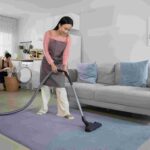
Engineered hardwood floors offer the perfect blend of elegance and durability, making them a popular choice for homeowners. To ensure these floors retain their beauty and resilience over time, proper cleaning and maintenance are essential. In this extensive guide, we will delve into every aspect of caring for your engineered hardwood floors. From understanding the construction of engineered wood to daily cleaning routines, addressing specific challenges, preventive measures, and long-term maintenance, let’s embark on a journey to keep your engineered hardwood floors in pristine condition.
See also our related post on How to Clean and Maintain Your Porcelain Tile Flooring which you will not want to miss.
Understanding Engineered Hardwood
Engineered Wood Construction
Engineered hardwood consists of multiple layers of wood veneers, topped with a hardwood wear layer. This construction enhances stability and minimizes the expansion and contraction common in solid hardwood. Understanding this composition is crucial for effective care.
Characteristics of Engineered Hardwood
Engineered hardwood inherits the natural warmth and beauty of hardwood but is more resistant to moisture and temperature fluctuations. Knowing these characteristics helps you tailor your cleaning routine to the specific needs of engineered wood.
Types of Engineered Hardwood
Engineered hardwood comes in various wood species, each with its unique characteristics. Whether you have oak, maple, or hickory, understanding the type of wood in your engineered flooring influences the cleaning products and methods you should use.
Engineered Hardwood Finishes
Different finishes, such as matte, satin, or gloss, determine the appearance and maintenance requirements of engineered hardwood. Familiarize yourself with the finish of your floors to adopt the most suitable cleaning routine.
Engineered vs. Solid Hardwood
Distinguish between engineered and solid hardwood characteristics. Engineered hardwood, with its layered construction, is often more versatile, but both types require careful cleaning to maintain their integrity.
Here is our post on How to Clean and Maintain Your Ceramic Tile Flooring which will aid you better understanding in floor cleaning.
Daily Cleaning Routine
Gentle Dry Dusting
Initiate your daily cleaning routine with gentle dry dusting using a soft-bristle broom, microfiber mop, or a vacuum with a soft brush attachment. This prevents abrasive particles from scratching the surface of your engineered hardwood.
Regular Vacuuming
Regular vacuuming helps remove dirt and debris that dry dusting might miss. Ensure your vacuum is set to the appropriate height to avoid scratching the surface, and use attachments designed for hardwood floors.
Damp Mopping
Damp mop your engineered hardwood floors using a well-wrung mop and a pH-neutral hardwood floor cleaner. Avoid excess water, as prolonged exposure can damage the wood. Mop in the direction of the wood grain for optimal results.
Dealing with Spills
Address spills immediately to prevent damage. Use a soft, absorbent cloth or paper towel to blot the spill. Avoid using excessive water, as it can seep into the seams and cause swelling.
Choosing the Right Cleaning Products
Selecting the right cleaning products is crucial. Opt for pH-neutral, hardwood floor-specific cleaners to avoid residue buildup. Avoid harsh chemicals, ammonia, and abrasive cleaners that can damage the finish.
Tackling Specific Challenges
Removing Scuff Marks
For scuff marks, use a soft, damp cloth and a small amount of baking soda. Gently rub the scuff marks, applying minimal pressure. Wipe the area clean with a dry cloth.
Addressing Pet Accidents
For pet accidents, clean the affected area promptly using a hardwood floor cleaner. If stains persist, consult a professional for advice on more extensive cleaning or refinishing.
Handling Water Damage
If water damage occurs, such as a leak or spill, address it immediately. Dry the affected area thoroughly, and use fans or dehumidifiers to prevent lingering moisture that could damage the wood.
Repairing Minor Scratches
For minor scratches, use a hardwood floor scratch repair pen or marker. These products help camouflage scratches and blend with the color of your engineered hardwood.
Dealing with Fading
Protect your floors from fading by minimizing exposure to direct sunlight. Use curtains or blinds to control sunlight and consider area rugs or furniture rearrangement to distribute light exposure evenly.
Preventive Measures
Area Rugs and Mats
Place area rugs or mats in high-traffic areas and entryways to minimize wear and tear. These act as a barrier, trapping dirt and preventing it from scratching or damaging the engineered hardwood.
Furniture Pads
Attach furniture pads to the legs of chairs, tables, and other heavy furniture to prevent scratches and dents. Ensure the pads are clean and in good condition to avoid transferring dirt.
Using Door Mats
Encourage the use of doormats at entryways to reduce the amount of dirt and debris tracked onto your floors. Regularly clean or shake out the mats to maintain their effectiveness.
Controlling Humidity
Maintain a consistent indoor humidity level to prevent expansion or contraction of the wood. Use a humidifier in dry conditions and a dehumidifier in humid climates to keep the environment stable.
Trimmed Pet Nails
Keep pets’ nails trimmed to prevent scratches on your engineered hardwood floors. Regular grooming ensures your furry friends’ nails won’t cause damage to the wood surface.
Long-Term Maintenance
Professional Deep Cleaning
Consider professional deep cleaning every few years to remove deeply embedded dirt and rejuvenate the wood. Professional cleaning services use specialized equipment and products suitable for engineered hardwood.
Sanding and Refinishing
Unlike solid hardwood, engineered hardwood has a limited number of times it can be sanded and refinished. Consult with a flooring professional to determine if sanding and refinishing are viable options for your specific floors.
Regular Inspections
Conduct regular inspections of your engineered hardwood floors. Look for signs of wear, scratches, or changes in color. Addressing issues promptly can prevent them from becoming more significant problems.
Replacing Damaged Planks
If individual planks are severely damaged, consider replacing them. Engineered hardwood allows for individual plank replacement, making it a cost-effective solution for localized damage.
Consultation with Flooring Professionals
When in doubt or faced with significant issues, consult with flooring professionals. They can provide tailored advice, perform inspections, and offer solutions to ensure the longevity of your engineered hardwood floors.
See also our post on The Complete Guide to Cleaning and Maintaining Your Laminate Flooring
Conclusion
Cleaning and maintaining your engineered hardwood floors requires a combination of daily care, addressing specific challenges, adopting preventive measures, and thinking about long-term maintenance. You can preserve the natural beauty and durability of your engineered hardwood floors by knowing the composition of engineered wood, establishing a daily cleaning routine, tackling challenges with care, preventing potential issues, and seeking professional guidance when necessary. With these thorough guidelines, your floors will continue to be a timeless and elegant foundation for your home.







